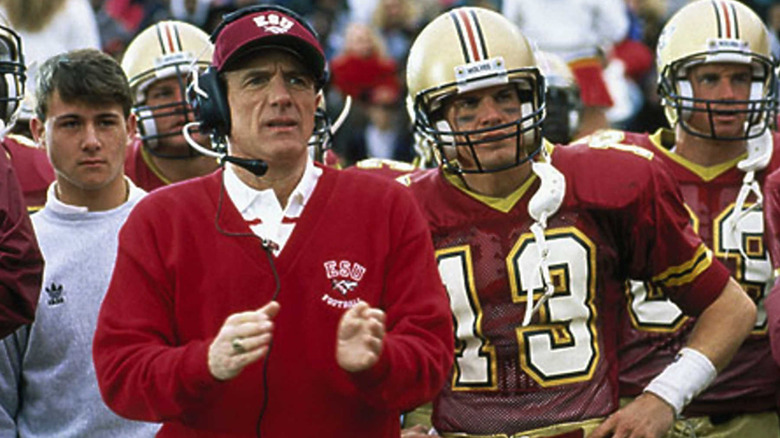
James Caan, who died on July 6, 2022, was a Big Ten college quarterback for Michigan State in the 1950s. A quarterback is the football equivalent of a field general. He must convey the unmistakable quality of leadership all while taking blows from all directions and never stopping to bask in the glow of his dazzling accomplishments. Even at their brashest, great quarterbacks are no-nonsense, and even when they lose, quarterbacks have to keep their heads held high.
Caan was also a no-nonsense actor. Frills were never part of his performances, and even as his most revelatory there was something straight-forward about his brilliance. If he wasn't the film's leading man, he conveyed the sense that he was the lead of a separate picture that just happened to crossover with the film he was currently in. Caan took losses throughout his life and career, but you never saw them accumulate on-screen. Every time Caan made a movie, he came to win, pure and simple. Maybe that's why he made a dozen films worth seeing that didn't even make our 15 Best Movies list. That's what no-nonsense winners do. Here are 12 underrated James Caan movies you really need to see.
The Way Of The Gun (2000)
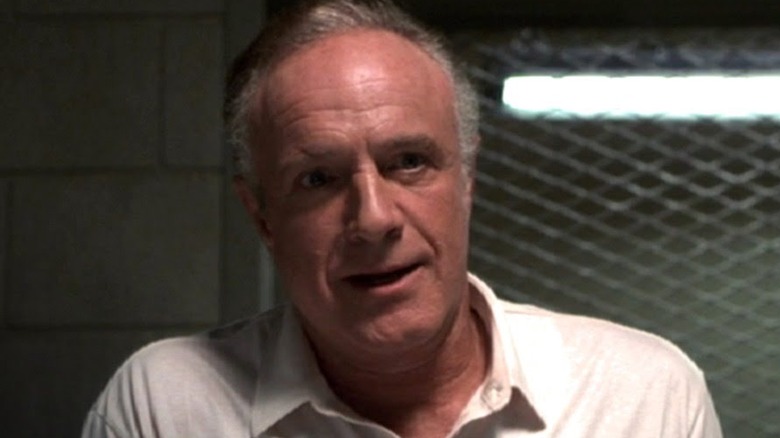
"The Way of The Gun" is an ugly-hearted movie. It quite literally begins with two obnoxious club-goers (including a not-yet-famous Sarah Silverman) hurling derogatory epithets at two equally obnoxious criminal drifters (Ryan Phillipe and Benicio Del Toro), who then proceed to hurl misogynistic epithets at the club-goers before beating them down sophomorically. It's like someone genetically engineered the worst first date scene ever and then filmed it impeccably. This movie does not crave your empathy. It exists, in part, to test it. That's by design.
In case you didn't know, "The Way of The Gun" is the directing debut of Tom Cruise whisperer Christopher McQuarrie. It bears his best hallmarks, but they're diamonds in the movie's proverbial rough. The dialogue is course but sonically brilliant. The constant subversion of crime and western tropes is electric but also provocative to the point of cringe. And then there's James Caan, who gives a textured performance so low-key gorgeous it sort of takes your breath away. Caan's Joe Sarno is the contrapuntal note to Phillipe and Del Toro — one who suggests their brash offensiveness is a destructive folly of youth, and tenderly introduces mortality's weight to the movie's fray. "[The] thing you can assume about a broken-down old man is that he is a survivor," Caan notes during the movie's midsection. Like any notable trial, "The Way of the Gun" is a movie you fight through, but it's also one you remember vividly. Don't say I didn't warn you.
Eraser (1996)

Few directors have ever had a run of films like Chuck Russell. No, the filmmaker has never directed a movie that's likely going to make The Criterion Collection or an AFI list (at least one of them should), but from 1987-1996, Russell helmed the best "A Nightmare on Elm Street" movie, the ecstatically gory "The Blob," Jim Carrey's seminal comedy "The Mask," and "Eraser." All of these movies rule in their own way. "Eraser," specifically, rules because it features Arnold Schwarzenegger bursting into the reptile house of Central Park's zoo, guns blazing, while guitar solos rip in the background. That's Criterion-worthy stuff. Two minutes later, he's killing henchmen via crocodiles. That might be even better.Truly, everyone and everything in "Eraser" elevates it to a slightly higher plane than it occupies on paper. The threadbare plot — a U.S. marshal who "erases" witnesses gets too close to a conspiracy and forces wish him dead — is an excuse for Russell to stage elaborate and gonzo action beats. In "Eraser," Arnold doesn't just dive from a burning plane to snare a free-falling parachute, he then uses that parachute and attacks the burning plane. The movie's default setting is "too much." But everyone comes ready to play on an excessive wavelength, including James Caan. Caan parlays his no-nonsense charms into a treacherous marshal who becomes the movie's heavy. He overdoes it, yet it feels just right. That's the Chuck Russell way, and "Eraser" is a glorious example of it.
The Program (1993)

James Caan's football experience manifested on-screen at multiple crossroads of his career. It happened most notably during 1971's "Brian's Song," but more interestingly in 1993's "The Program." This isn't a knock on "Brian's Song," which is one of the best football and Chicago sports movies ever made. It's praise for what "The Program" specifically asks of James Caan, a colossal acting talent that happened to fundamentally understand the insane demands college football places on its players. The results are exhilarating.
"The Program" is about a college football coach (Caan) who looks the other way when his players' reckless behavior leads to a winning season. Sometimes this behavior is genuinely funny. The sequence where Alvin Mack psyches out an opposing running back by incorrectly identifying him as the guy who shot his mom is breathtakingly wrong and hysterical. On other occasions, it yields real pathos. A subplot between a transfer student and football recruit named Darnell (Omar Epps) and his tutor, Autumn (Halle Berry), is filled with grace notes that play on race, class, and stereotypical assumptions equally, many of which stem from ESU's increasingly unethical practices. In this way, "The Program" is a step up from director David S. Ward's more famous "Major League." While it lacks that film's iconic moments or portraits of how sports can transform a metropolis, "The Program" is authentic and funny. That makes it worth a look.
Flesh And Bone (1993)

There's an argument to be made that "Flesh and Bone" is the most underrated movie of James Caan, Dennis Quaid, Meg Ryan, and Gwyneth Paltrow's respective careers. Steve Kloves' noir western doesn't lack noticeable star power. It's drenched in tension from the first frame and creeps towards its conclusion like nails running down a chalkboard. One wouldn't accuse it of being pleasant; noir rarely is. While the movie devolves into a series of coincidences that fall apart on paper, Kloves and his able cast still land them like gut punches. There's an economy to the film that foreshadows the expert adaptation skills Kloves would unleash in his "Harry Potter" scripts and follow-up feature, the excellent Michael Chabon tale "Wonder Boys." "Flesh and Bone" doesn't overstay its welcome.
That also gives it space to haunt you for days after, particularly James Caan, who has never been more steely than he is throughout Kloves' picture. Caan was never shy about playing disreputable or malicious characters. Here, he's downright evil. If you were wondering how much malice Caan's charisma could effectively mask, "Flesh and Bone" is a tremendous answer.
Silent Movie (1976)
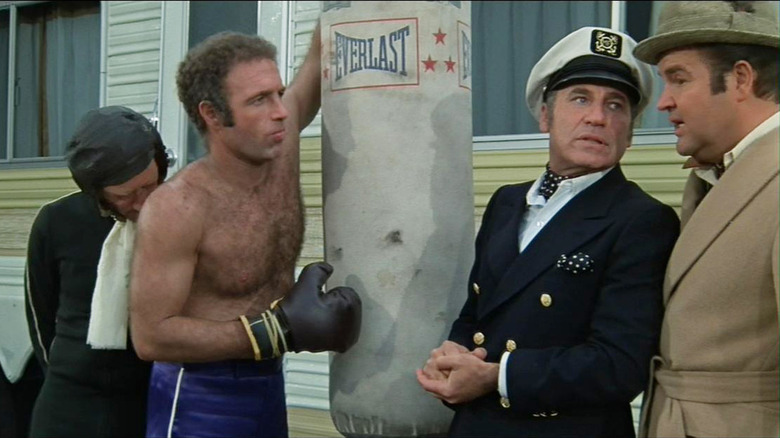
"Silent Movie" is easily among the best movies where actors play themselves. Mel Brooks' reliably zany and sharply satirical skewering of the film industry features a host of the 1970s biggest stars sending their images up, from James Caan to Liza Minnelli to Burt Reynolds. Each has a deeply enjoyable time. Caan, in particular, brings swagger and a devilish playfulness to the sequence he anchors, in which director Mel Funn (Mel Brooks), Dom Bell (Dom DeLuise), and Marty Eggs (Marty Feldman) covertly recruit Caan for their project while he's on location for an already funded movie. If this sounds awesome, that's because it is. And, inexplicably, "Silent Night" is no longer one of Brooks' most remember comedies despite that awesomeness.In fairness, Brooks' copious 1970s references and silent movies themselves have both gone out of vogue. "Spaceballs" satirizes a franchise that's still very much in the pop-culture lexicon, and "Silent Movie" isn't as trailblazing as "Blazing Saddles," nor is it so easily adaptable for the stage as "The Producers" and "Young Frankenstein" were. That's a shame because, in its bridging of two disparate cinematic styles and decades, it reveals Brooks' singular artistry. We shouldn't stay silent about its excellence.
Games (1967)

Of all the films on this list, "Games" feels ripest for rediscovery. The film's sparse settings and twisty plot are a dark predecessor to the currently en vogue run of star-studded murder mysteries ("Knives Out," "Death on the Nile," "See How They Run"), but they also channel Alfred Hitchcock as well as Henri-Georges Clouzot's landmark thriller "Diabolique" expertly. It doesn't hurt that "Games" and "Diabolique" also share the Oscar-winning powerhouse, Simone Signoret. It also doesn't hurt that both Katharine Ross and James Caan appear in it early into their careers, still chomping at the bit to make their names.
The result is a movie that's rough around the edges yet elegant and shocking. You can see why it's been lost to time while simultaneously understanding how anyone could prefer it to thrillers from the era critics celebrate today. The less said about "Games," the better. It plays by a specific set of rules too good to spoil here and, if you don't know them, they're worth finding out.
Les Uns Et Les Autres (1981)

There are epic films and then there's 1981's "Les Uns et Les Autres" (also known as "Bolero"). Claude Lelouch's generational epic spans four separate countries — France, Germany, the United States, and Russia — partly occurs during World War II and the Holocaust, and brings multiple stories together through a grand, cathartic ballet sequence. The movie won the Technical Grand Prize at 1981's Cannes Film Festival, and you only need to get minutes into its runtime to understand why. That "Les Uns et Les Autres" finds moments of restraint and subtlety is almost miraculous.
Thankfully it does, which is one of many reasons one should rush to see it. To explain the plot of "Les Uns et Les Autres" is beside the point. Instead, know that the movie succeeds because it works both as a testament to the power of art and a lavish explosion of cinematic art's possibilities. It wants to make you believe in the need to create and express; it's hard to imagine getting through all three ecstatic hours of it and feeling otherwise.
City Of Ghosts (2002)

Despite a romantic subplot that overtakes its much more interesting "mentor has gone missing" story, Matt Dillon's feature directorial debut effort is a deeply felt James Caan showcase. At times, it feels constructed solely for that purpose. "City of Ghosts" is technically premised on a con man played by Dillon traveling halfway around the world to Cambodia in the hopes of retrieving insurance fraud money from a trickster played by Caan. Caan, as a character and performer, has to be worthy of that journey.
Put simply, the best version of "City of Ghosts" would be a feature-length meditation on misdirection and mortality. The film understands that you can't con a world you no longer understand or belong in, and, when Cann and Dillon share the screen, that thesis feels almost palpable. Caan, in particular, conveys the tug of war between the drive of ambition and the weariness of old age, showing his character's struggle to let go in quiet yet loaded moments. It's arresting stuff. Even if "City of Ghosts" can't live up to the bar Caan sets, it's a sterling reminder of how high he could raise a project's internal expectations simply by walking on screen.
Hide In Plain Sight (1980)

James Caan was a director, but "Hide in Plain Sight" was the only film he helmed, which is a shame. The stranger than fiction story, adapted from the book by Leslie Waller and inspired by the real-life case of a Buffalo man whose children were seized by the United States government, is imperfectly executed. The movie is also a guide to what Caan valued as an artist: It concerns a working-class guy who fights for what's right. Caan would often hardscrabble characters on either side of the law. It displays a deep interest in both suspenseful filmmaking and unobtrusive poignancy. On both counts, it delivers.
Yes, "Hide in Plain Sight" suffers from pacing issues and feels like the work of a first-time actor turned filmmaker. The same could be said of the (better) Ben Affleck's "Gone Baby Gone" or Clint Eastwood's "Play Misty for Me." There are enough bursts of excellence to recommend "Hide in Plain Sight" and suggest Caan could've crafted any number of superior follow-ups. Watching it feels like a eulogy for both his artistry and the filmmaker that never was.
Mickey Blue Eyes (1999)
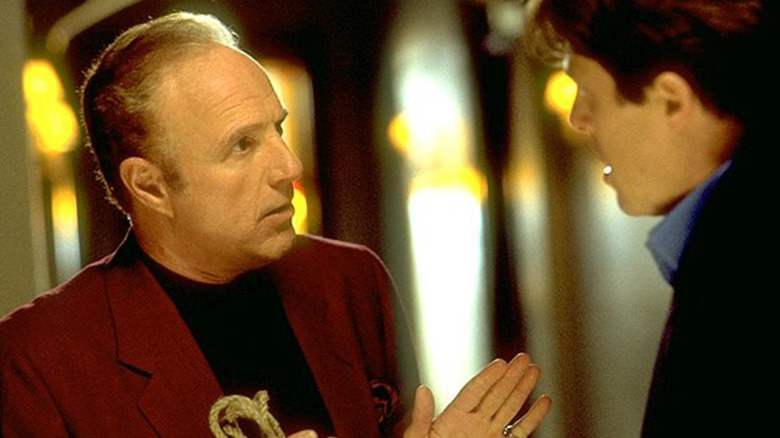
"Mickey Blue Eyes," a movie about an English auctioneer (Hugh Grant) whose future father-in-law (James Caan) is a mafia enforcer, was released in 1999. "Analyze This," a movie about a New York therapist (Billy Crystal) whose latest client is a mafia enforcer (Robert De Niro), was also released in 1999. To say this did "Mickey Blue Eyes" no favors is an understatement. Both films feature iconic performers from "The Godfather" films riffing on their mob movie lineage, but only "Analyze This" was directed by comedy legend Harold Ramis and partially conceived of by "Manchester by the Sea" scribe Kenneth Lonergan. "Mickey Blue Eyes" is good, but it never approaches the level of genius that Ramis and Lonergan tap into with alacrity.
Let me repeat, though: "Mickey Blue Eyes" is good! Caan resists the temptation to ham it up even when winking at his prior, infamous performances. Grant is also a delight throughout, particularly when learning mafioso ways and, later, implementing them poorly. Just because "Mickey Blue Eyes" can't compete with the film it's compared to doesn't mean it isn't worthy.
The Good Neighbor (2016)
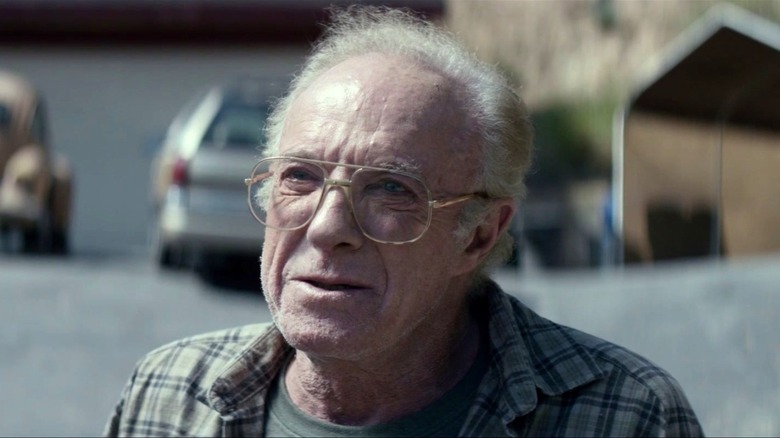
"The Good Neighbor" isn't a swan song for James Caan's career, yet it incidentally functions as one. Kasra Farahani's psychological thriller about two teenagers (Logan Miller, Keir Gilchrist) who enter into a series of cat and mouse games with an enigmatic man named Grainey (Caan) hinges on Caan's ability to be whatever the story demands. He matches those asks and then some. If the asks don't make sense, they're hardly Caan's fault. He uses all the skills at his disposal to make them more believable than they'd be on the page.
This is why "The Good Neighbor" is an aching testament to Caan's excellence. He renders a two-dimensional and unrealistic character into a multi-faceted human, by turns frightening and empathetic. If the movie were better, the film would be remembered as a reminder of Caan's greatness, though it still works on that level. In the wake of Caan's passing, there might not be a better time to watch it.
Cloudy With A Chance Of Meatballs 2 (2013)

Believe it or not, "Cloudy with a Chance of Meatballs" is a top 10 James Caan film. To be clear, Phil Lord and Christopher Miller's animated feature is excellent and deserves all the lavish praise in the world. It's a fiendishly imaginative adaptation of Judy and Ron Barrett's iconic children's book, and one that's aged like fine, Flint Lockwood-created scotch. "Cloudy with a Chance of Meatballs 2," however, is also excellent. Even if it doesn't hit the same ecstatic highs as Lord and Miller's original, it brings its joyous insanity to the table.
For one, its script was co-written by John Francis Daley, the "Horrible Bosses" and MCU "Spider-Man" scribe who would co-direct and write "Game Night." Daley has a singular comic voice and rhythm, one both quick and considered, and it plays like gangbusters in the world of Swallow Falls. For another, the film is Steven Spielberg's "The Lost World" but with food. Flint (Bill Hader) and his ragtag crew return to the site of the original "Cloudy" to find it overrun by anthropomorphic foodstuff creatures that knowingly wink at dinosaurs and creatures from the "Jurassic Park" universe. The result is a gateway pulp adventure film that is only a case of diminishing returns when compared to the original, a picture that consensus estimation should be higher.
Read this next: 13 Box Office Bombs That Are Truly Worth A Watch
The post 12 Underrated James Caan Movies You Need To See appeared first on /Film.
from SlashFilm https://ift.tt/Lg6vKPp


No comments:
Post a Comment